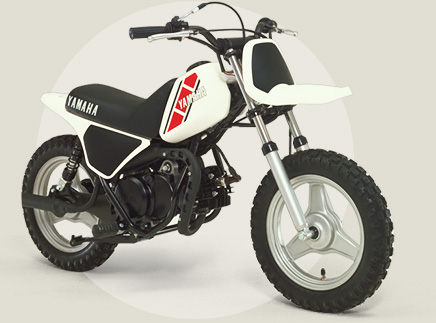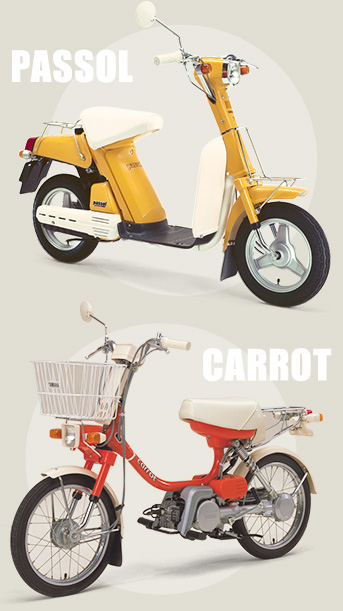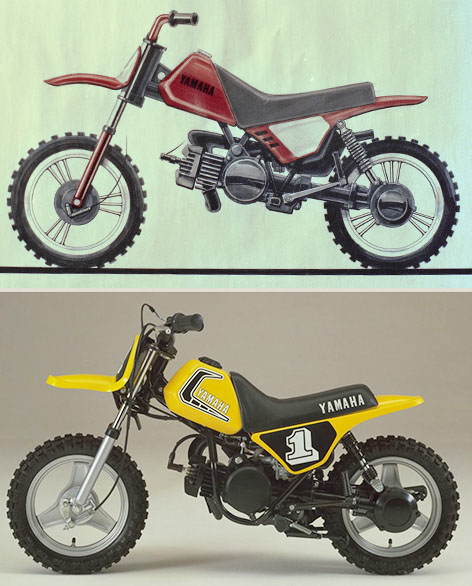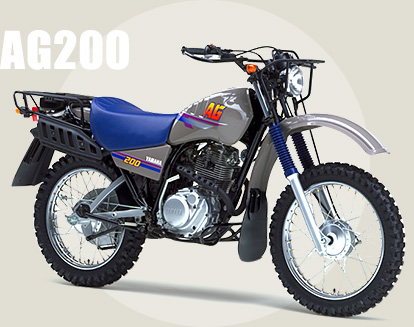Yamaha’s pioneering of off-road bikes continued with an even greater pace after the mid-1970s with models like the TT500, which targeted enduro riding enthusiasts that populated the west coast of the U.S., and the dual-purpose XT500 that was based on it. From there, the XT evolved into the Ténéré as introduced in Chapter IV, but from the mid-1970s through the 1980s, Yamaha was aiming to refine each series in its lineup while proposing new ways to enjoy the world of off-road riding.
The PW50 in particular, a small bike designed for kids to enjoy that debuted in the U.S. in 1980, is a long seller that is still popular today. Yamaha’s passion for off-road riding dwells in this little package as well.
 The first-generation PW50 made its debut in the summer of 1980. From 1981 on, it was sold in North America, Europe and various regions, gaining widespread popularity.
The first-generation PW50 made its debut in the summer of 1980. From 1981 on, it was sold in North America, Europe and various regions, gaining widespread popularity. The PW50 at an exhibition in Paris in 1980. Its seat stretched up onto the fuel tank, a design implemented ahead of the YZ production model pictured behind it.
The PW50 at an exhibition in Paris in 1980. Its seat stretched up onto the fuel tank, a design implemented ahead of the YZ production model pictured behind it.
 The 1979 YZ50 was also sold in Japan.
The 1979 YZ50 was also sold in Japan.The PW50 debuted at a dealer show in the United States in the summer of 1980. It went by names like the “Peewee” and “YZinger,” but it was without a doubt “the smallest flagship model” to come from Yamaha’s off-road endeavors.
In the late 1970s, Yamaha had conquered the top levels of international motocross. Heikki Mikkola rode the YZM400 factory bike to win the 500cc Motocross World Championship in 1977 and 1978, and the YZ400/250/125 production models racked up a considerable amount of acclaim in AMA competition. In 1979, shipments of the lightweight YZ50 (14-inch front and 12-inch rear tires) to the U.S. market began. But by the end of the 1970s, it appeared that the off-road trend was starting to show a downturn in popularity.
Amidst this, Yamaha was looking for a way to lower the hurdles for users to start riding off-road. One of the ideas was to create a fun bike that children could easily get familiar with. There were a number of “mini-motocross” models with 10-inch front and rear wheels sold by other manufacturers at the time, but the Yamaha team wanted theirs to have the look of a real motocross machine and a gear shifter. Yamaha’s approach was: if we’re going to build a motorcycle with the idea of children trying riding for the first time, it should be something familiar and fun to play with for them. A later request from Yamaha Motor Corporation, U.S.A. (YMUS) gave the idea a boost. Takashi Matsui, a retired Yamaha employee, recollects:
“In those days, we were developing motocross model variations, including ones with smaller-displacement engines. But the idea came up to pursue something outside models for competition. The target was complete beginners, kids around five or six years old. Kids that had finally learned how to ride a bicycle could now experience the fun of controlling their first motorized vehicle; that was the visual we were after. So the requirements we had to cover with every part of the bike during development included exterior styling, a sense of safety, ease of use and an affordable price.” Development began in early 1979, at just about the same time that the YZ50 began shipping out.
Matsui had long been involved in the development of factory machines for the Road Racing World Championship and several other production models for racing. Matsui and his coworkers had always quested for more power, higher top speeds and greater performance, so the PW50 was a complete 180-degree shift. They supposed that it would be a great way to give children who could ride a bicycle their first taste of an engine and a way to learn the joys of motorcycling surrounded by the smells of a dirt course.
The image they had was that of a child in the U.S. receiving one as a Christmas present. That’s also why they wanted it to be small enough that it looked like it could fit down a chimney, and that the exterior should be familiar to kids—like a toy. They also wanted to avoid the messy nature of a chain drive. A separate system for adding oil was also a must. As they took these ideas into consideration, a more concrete model plan began to come together.
Looking at existing models at the time, Yamaha had the Passol 50cc scooter (released in Japan in 1977) with 10-inch wheels, and the Carrot (released in Japan in 1979; exported as the “QT50”), a 49cc single-cylinder automatic-transmission scooter with a shaft drive. Matsui and his team decided to combine these two models. Shaft drive was low-maintenance and reduced worries about dirt clogging, but it was difficult to find a compromise to successfully pair the body made for 10-inch wheels with the existing engine. It didn’t quite fit the “toy” image that the engineers were after.


 A design sketch of the PW50 while it was under development (above); a yellow/black PW50 for the U.S. market (below)
A design sketch of the PW50 while it was under development (above); a yellow/black PW50 for the U.S. market (below)
At that point, the team decided to draw several full-size illustrations. At the time, the biggest of such drawings were done at half the actual model size, so full-size illustrations were unheard of. From that point, they reached a common idea for the bike and worked out the details—the end result was a very unique style of bike.
The primary exterior features were its all-in-one construction for the rear fender, air cleaner box and racing number plate, and the rounded looks to its silhouette. It had a standout style that differed from a motocross machine purely for off-road riding and it also didn’t look like just a smaller version of the YZ. With a one-piece part covering three functions, the total number of parts required to build it was reduced, in turn leading to a lower overall retail price. Resin fuel tanks were already in use on YZ Series models, but the PW50 went a different route, using a new all-purpose method called blow molding instead of the rotational molding used for YZ model fuel tanks. This not only helped lower weight but also gave the tank a pristine finish on par with the YZs.
 A small shroud was added to the blow-molded resin fuel tank starting with the 1984 model.
A small shroud was added to the blow-molded resin fuel tank starting with the 1984 model.For children, the power needed to be easy to manage. To accomplish this, two power limiters were added: a speed limiter adjusting screw for the throttle and a power reduction plate in the exhaust pipe. “We used the same engine as the model adults rode, so durability wasn’t a problem at all,” explains Matsui. “Maybe the only challenge we had was reducing the power. At first, we put a plate with a 7 to 8 mm hole in it in the exhaust pipe, but that reduced it too much so the rpm wouldn’t come up and the bike wouldn’t move forward. There wasn’t enough rpm to engage the centrifugal clutch. In the end we altered the size of the hole in the plate a number of times and eventually fixed it. Thinking back on it, it’s a pretty funny story.” For engineers that had spent most of their careers pursuing more power, looking for ways to limit power instead ended up being a somewhat unexpected hurdle.
When the production prototype was completed, a group of kids aged five to seven were invited to an area near Yamaha Motor headquarters and tried it out. Once they were shown how to ride it, they started out slowly, but ended up having so much fun that they didn’t want to stop. Matsui recalls, “They were having fun like it was a ride at an amusement park. They just didn’t want to stop riding.”
In September 1980 a few months later, the PW50 made its debut in Las Vegas in the U.S. at a Yamaha dealer show. It had a modern design for the time with the seat extending up onto the fuel tank, but its cuteness set it apart. Following that, the PW50 continued to draw considerable attention at shows in Cologne, Germany and Paris, France.
 A child learning to ride a PW50 at an event in Australia
A child learning to ride a PW50 at an event in AustraliaIn addition to its toy-like familiarity, the PW50 also had a certain charm. The center stand helped kids first understand the sound and vibrations of a motorcycle engine while sitting on the bike; the two-part limiter system was just right for kids to learn how to ride slowly first; the separate oil filler was convenient to use; and the shaft drive meant less needed maintenance. The PW50 was a massive hit in the year of its introduction in North America, Europe and Oceania, with over 8,000 of them shipped and sold.
The PW50’s hardware wasn’t the only reason for its popularity. In each region, Yamaha’s off-road enthusiasts dedicated themselves to holding regular test-ride events for kids. At the same time the PW50 went on sale in 1981, Yamaha Motor Australia held a test-ride event for it, the Passol and other models at a shopping center on the outskirts of Sydney. This was what made “Peewee” the widely known namesake of the PW50. Steven Cotterell, Managing Director of Yamaha Motor Australia and New Zealand, reminisces about that time:
“We decided right from the beginning that we wanted to teach kids to ride. So we created this thing called the ‘Peewee Adventure Club,’ and we involved a very famous motocross rider in Australia. We’d have sessions where the kids would be riding under full supervision from Yamaha so the parents could sit back, relax and watch their kids. After that, the kids still remembered what great fun this was, so the kids were being taught to ride properly and then they carried on through their riding career in a safe way.” The PW50 has been a starting point for many on their way to becoming world-class riders.
The PW50 also changed the way families thought about motorcycles. “The best thing was having the moms there,” Cotterell recalls. “Not all moms are excited about the idea of their kid riding a bike, but when they saw their kid having a great time, their thinking changed. They saw that riding the PW50 was a good, healthy, family thing for their kid to do. And before you knew it there was a real fraternity growing among all parents. When you go to any minibike race today, you’ll see the parents all getting on together, communicating, and having great family time. It’s a good thing, a good healthy sport.” The PW50’s role in riders stepping up through the lineup was also important, says Cotterell. “Having kids moving up and sticking with Yamaha bikes is something you can’t really do with other brands. If they keep stepping up to bigger machinery with Yamaha every time, they’ll have blue blood running through their veins eventually.” That was and still is what makes the PW50 special.
Such efforts to spread the PW50’s use contributed to its popularity in the U.S. as well. An event symbolizing the sheer market presence of the bike were the PW50 races for kids at AMA Supercross races in the 1980s. Rather than using the main course with all its jumps, there was a special course that the small PW50s could navigate and race around. At each round the spectacle of tiny riders matched with big helmets riding, crashing and getting back up to ride again brought down applause that rivaled the main events.
 PW50 riders awaiting the start of their race at the AMA Supercross round in Anaheim in 1984 (above); kids riding in a PW50 race in 1985 at the Anaheim round of the AMA Supercross season (below)
PW50 riders awaiting the start of their race at the AMA Supercross round in Anaheim in 1984 (above); kids riding in a PW50 race in 1985 at the Anaheim round of the AMA Supercross season (below)

The PW50 is not the only model in Yamaha’s off-road lineup worthy of being praised for its originality. In 1974, six years before the PW50 made its debut, Yamaha released the AG100 and AG175 models based on its DT Series.
The “AG” in the product name stands for “Agriculture.” These bikes were well-equipped for herding and raising livestock like sheep and cattle on Australian farms. Yamaha listened to local farmers about the things they needed daily in a motorcycle and created the AG Series. They took full advantage of the deep torque available with a 2-stroke engine and made various creative additions to the chassis.
Features included large handguards, sidestands on both sides, a headlight guard that doubled as a front rack, a large rear rack, a seesaw gearshift lever and a fully-enclosed chain, each focused on adding to the bikes’ mobility and usability on the farm.
A quiet exhaust note was useful for things like returning a little lamb that had wandered away from the flock. Yamaha’s knowledge gained in the development of off-road machines was put to use in the world of dairy farming. Though it was included in Yamaha’s “business model” lineup, the bike’s base still retained Yamaha’s painstakingly developed off-road handling characteristics. This shone through such that even while riding it primarily for farming purposes, the number of users that enjoyed taking it for off-road treks quietly grew and these Yamaha machines became known for their trail-riding capabilities as well.
The 4-stroke AG200 was released in 1983 and sold in Japan as well two years later. “They had to come up with something that could deal with daily life on the farm,” says Cotterell. “So it really had to be an adaptable, tough, reliable bike that was also easy to repair. And they did it; I’d say the first AG100 was perfectly suited to farming. Then the AG200 was a 4-stroke; it was just simply put the petrol in and go, and it was a chance to develop the concept further. It had a new chassis, better handling and a bigger displacement. They really redefined the AG bike with the AG200. And farms in Australia are huge, so you need the extra capacity to do long distances. Its triangulated Monoshock suspension was pretty neat.”
The AG200 was based on the XT200, but interestingly, there was a 225cc ATV model being developed ahead of the AG200 and the engine know-how gained from that ATV was then fed into creating the AG200. That resulted in the AG200’s signature performance at very low speeds. The bike’s exhaust fumes—known to bother sheep and cows—were also reduced. Another feature was that the area of the fully-enclosed chain case near the swingarm pivot was made of reinforced ribbed rubber, so that sheep dung would be easy to wash off if it got stuck there.
The AG Series remains in use today on farms throughout Oceania, Mongolia and various African countries and is also used for transport. Yamaha’s off-road lineup from the 1980s diversified further, expanding to include the AG, XT, TTR, WR, BW and TW series of models. Among them, one thing that stands out about AG bikes is that they subtly won many over to the joys of off-road riding through daily use on the farm. It was developed by Yamaha’s own off-road enthusiasts, so that may not come as a surprise.
■■■■■
They aren’t the fastest machines and they don’t particularly excel at performing jumps or crossing difficult terrain, but bikes like the AGs and the PW50 without a doubt convey the genuine off-road passion that Yamaha instills into every model for the dirt.
 The AG100 (1977 model)
The AG100 (1977 model)
 The AG100 is still being sold with no major changes made to it since 1996.
The AG100 is still being sold with no major changes made to it since 1996.
 The AG200
The AG200





